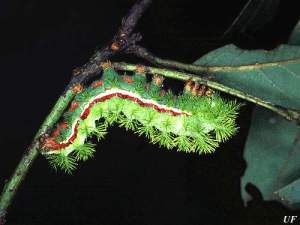by Katie Bowell, Curator of Cultural Interpretation
The first day of summer is soon upon us, and summer only means one thing: butterflies! (Actually, according to an informal poll of friends and coworkers I took before I wrote this post, apparently “summer” also means swimming, cookouts, camping and golf [I know, I don’t get that last one, either]). But this is my post, so butterflies it is!
There are over 250 species of butterflies and moths here in Larimer County, and one of the best ways to maximize your butterfly-viewing abilities this season (other than drenching yourself in Gatorade…but that’s a story for another post) is to grow a Butterfly Garden. Here’s how:

Image courtesy of Barry Weber
Step 1: Choose your butterflies
Now, you’ll never have complete control over which butterflies visit your garden (unless you set up little butterfly bouncers to keep those riffraff Cabbage whites out), but you can influence who’s visiting by the plants you grow. So, what butterflies would you like to see?
The “Butterflies and Moths of North America” (BMONA) website is a great place to learn which species frequent your region. There are also plenty of reference books at stores and libraries, and these come in handy for on-the-spot identification later. Start researching!
Step 2: Choose your plants
The butterflies you want to see will dictate the plants you grow. Butterflies need two types of plants: host plants and nectar plants. Host plants are the ones that butterflies lay their eggs on and caterpillars eat the leaves off of. Caterpillars tend to be very host plant-specific, and will only eat that one plant. Nectar plants have the flowers that supply butterflies with the nectar and pollen they eat, and butterflies are much less choosy about their nectar sources – dozens of species can visit the same flowers.
Worried about having a garden full of plants that look like Swiss cheese (not to be confused with the Swiss cheese plant, which caterpillars also eat)? Plant nectar sources. Want to be able to watch the whole butterfly lifecycle (egg, caterpillar, chrysalis, and butterfly)? Plant host plants and nectar sources. (P.S. The BMONA website also lists the known host and nectar sources for each of the species, so its one-stop information shopping!)

Image courtesy of Burning Silo
You may already be growing some host and nectar plants in your garden and not even know it. Here are some common Fort Collins examples:
Host Plants
Dill, Parsley, Carrot, and Celery: Swallowtails
Yucca: Giant Yucca Skipper
Alfalfa and Clover: Orange Sulphur
Thistle: Painted Lady
Milkweed: Monarch, Queen, and Solider
Nectar Plants
Marigold: Sulphurs
Dandelion: Skippers, Checkerspots
Aster: Skippers
Lilac: Swallowtails
Sweet pea: Skippers
Geranium: Swallowtails
Butterfly bush: Good grief, almost all of them!
By planting a combination of annuals and perennials that bloom at different times you can attract butterflies throughout the spring, summer and fall.
Step 3: Offer the butterflies more than just plants
Having host plants and nectar sources are the first steps, but there are other important elements to entice our scaled-wing (what the word “Lepidoptera” means) to your yard.
Shelter: Being light, delicate, and with wings that act like sails, butterflies aren’t huge fans of wind. By including windbreaks in your garden such as big rocks, trees, and bushes, you can reduce the wind levels in your yard and create an oasis of calm. These windbreaks are also common locations for caterpillars to select when it comes time to turn into a chrysalis.
Water: Speaking of oases, butterflies need water. If you provide areas where moisture can collect, you’ll see butterflies start “puddling,” or clustering around pools of water, mud, and even animal urine and feces to suck up water, salts, and other minerals. Those nutrients supplement what butterflies get from nectar and pollen and are also often used as nuptial gifts that the male will pass to the female when mating.

Image courtesy of Ashbuilder
Sunning Spots: As invertebrates, butterflies can’t internally control their body temperatures and need the sun to warm them. When the sun is out, butterflies will open its wings on a flat surface (like that big rock you put in as a wind break) to soak up the available solar energy.
High and Low Spots: Just like my neighbor’s Chihuahua, Sparky, butterflies are territorial. In many species, male butterflies will have territories and any female that enters that territory is fair game for attempted mating. Having high spots in your garden where males can perch allows them to scan for any incoming females and also any other males that may try to encroach on either their territory or their ladies.

Image courtesy of the Bermuda Monarch Conservancy
Don’t have your own garden (or, like me, you only have a tiny apartment balcony)? Here are some ideas:
Make Friends: Become friends with people who have their own gardens. If you’re lucky, they’ll invite you over and you can enjoy their garden and butterflies, hopefully with some lemonade (or something stronger) thrown in for good measure. Plus, you’ll have more friends.
Get Outdoors!: Visit the many Natural Areas and Open Spaces in Fort Collins and Larimer County. One of the great things about all of the natural spaces where we live is that they’re managed carefully to support native plants. Native plants = native butterflies = lots for you to see!

Butterfly at Pineridge Natural Area, image courtesy of Otto West
If you follow the above guidelines, you’ll soon be surrounded by flittering Fritillaries and swooping Swallowtails. Enjoy!



































You must be logged in to post a comment.